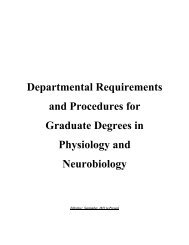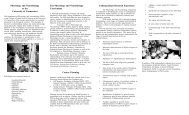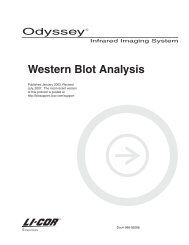Information Brochure (pdf) - Physiology and Neurobiology ...
Information Brochure (pdf) - Physiology and Neurobiology ...
Information Brochure (pdf) - Physiology and Neurobiology ...
Create successful ePaper yourself
Turn your PDF publications into a flip-book with our unique Google optimized e-Paper software.
We employ mouse (mus musculus) as the primary<br />
model organism for our investigations. Moreover,<br />
it has been reported that amongst all the tissues,<br />
the central nervous system has the highest amount<br />
alternatively spliced transcripts. Thus, we employ<br />
the neural retinal to elucidate the role of Alternative<br />
Splicing in neural development.<br />
Our current work has focused on the role of alternative<br />
splicing in regulating bHLH transcription<br />
factors during retinal development. Specifically,<br />
we have investigated the post-transcriptional regulation<br />
of one of the atonal homologues called<br />
Math5. We have found that this gene is a single<br />
exon gene, which is alternatively spliced to produce<br />
two isoforms. Interestingly, the major isoform is<br />
spliced such that the entire coding sequence is<br />
spliced out. Consequently, most of the RNA that<br />
is produced for Math5 cannot produce a functional<br />
protein. This raises several interesting questions,<br />
which will be the focus of our future investigations.<br />
First, why should retinal progenitor cells produce<br />
Math5-mRNA that does not code for protein<br />
Second, does the non-coding isoform of Math5<br />
have a function Third, is this form of regulation<br />
found in other bHLH transcription factors<br />
Selected Publications<br />
Kanadia, R. N. <strong>and</strong> C. L Cepko. (2010). Alternative splicing<br />
produces high levels of noncoding isoforms of bHLH transcription<br />
factors during development. Genes <strong>and</strong> Development 24(3):<br />
229-34<br />
Kanadia,R. N., V. E. Clark, C. Punzo, J. Trimarchi <strong>and</strong> C. Cepko.<br />
(2008). Temporal requirement of the alternative splicing factor<br />
Sfrs1 for the survival of retinal neurons. Development 135(23):<br />
3923-33.<br />
Kanadia, R. N., J. Shin, Y. Yuan, S. G. Beattie, T. Wheeler, C.<br />
A. Thornton <strong>and</strong> M. S. Swanson. (2006). Reversal of RNA missplicing<br />
<strong>and</strong> myotonia following muscleblind overexpression in a<br />
mouse poly(CUG) model for myotonic dystrophy. Proceedings of<br />
the National Academy of Sciences, USA. August 1st; 103 (31):<br />
11748-53.<br />
Kanadia R. N., K. A. Johnstone, A. Mankodi, C. Lungu, C.<br />
A. Thornton, D. Esson D, Timmers, W. W. Hauswirth, M. S.<br />
Swanson. (2003). A muscleblind knockout model for myotonic<br />
dystrophy. Science 302(5652): 1978-80<br />
Kanadia, R. N., Y. Yuan, M. G. Poulos <strong>and</strong> M. Swanson.<br />
(2005). Journal of Biomolecular Structure <strong>and</strong> Dynamics, Book<br />
of Abstract Albany 22(6)<br />
Lin, X., J.W. Miller, A. Mankodi, R. N. Kanadia, Y. Yuan, R.<br />
T. Moxley, M. S. Swanson, C. A. Thornton. (2006). Failure of<br />
MBNL1-dependent postnatal splicing transitions in myotonic<br />
dystrophy. Human Molecular Genetics 15 (13): 2087-97.<br />
Y. Yuan, R. N. Kanadia, M. S. Swanson. (2005). Impact<br />
of Unstable Microsatellites on RNA processing (Review).<br />
CHEMTRACTS Biochemistry <strong>and</strong> Molecular Biology 18(3):<br />
129-140.<br />
Kanadia, R. N., C. R. Urbinati, V. J. Crusselle, D. Luo, Y. J. Lee,<br />
J. K. Harrison, S. P. Oh, M.S. Swanson. (2003). Developmental<br />
expression of mouse muscleblind genes Mbnl1, Mbnl2 <strong>and</strong><br />
Mbnl3. Gene Expr Patterns 3(4): 459-62.





